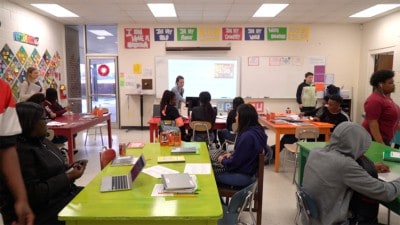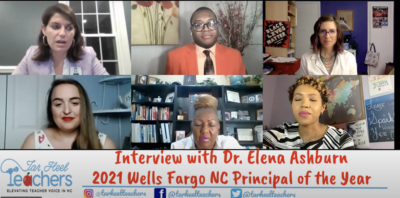
The following is the first in my monthly column, One Day and One Goal: Expanding opportunity in NC. I invite you to follow along as I share stories from classrooms and explore critical issues facing education in our state.
Thirty-one years ago, 23 Teach For America (TFA) corps members started their leadership journeys in the Triangle and eastern region of North Carolina. Rooted in the belief in the potential of all children and their right to an excellent education, they were the manifestation of a vision to recruit the best from our colleges and universities to teach in schools across the state, impacting thousands of students. That founding energy has been met with longstanding bipartisan support from some of our state’s most notable leaders, including Governor Roy Cooper who helped bring TFA to North Carolina back in the early 1990s, and Senators Phil Berger and Thom Tillis who assisted in making TFA’s 2014 expansion a reality.
The rich history and impact of TFA in North Carolina is what attracted me to align with its mission. As TFA shifts its structure in the state to better meet the needs of students and communities, I’m excited to lead its new statewide partnership.
Since launching sites in Charlotte and the Piedmont-Triad in 2004 and 2014, respectively, TFA has trained nearly 4,000 teacher leaders in North Carolina, reaching more than 250,000 students. Today, nearly 2,200 TFA corps members and alumni are living and working in North Carolina. Of our current 250+ North Carolina corps members, 50% identify as Black, Indigenous, and people of color (BIPOC).
Nearly two thirds of TFA alumni in North Carolina are working in education — approximately 500 of them are K-12 classroom teachers, and another 135 are school or district leaders. We have many that lead at the nonprofit and higher education level. And they are getting results for students. Twenty-one of our corps members and alumni classroom leaders were recognized as Teachers of the Year this past school year in our placement regions; including CeCe Sizoo-Roberson, who was a finalist for North Carolina Teacher of the Year; and LaKeia Colquitt, who was named Rookie Teacher of the Year for Guilford County Schools. The 2021 North Carolina Principal of the Year is also a TFA alum. Prior to serving as principal at Broughton High School in Raleigh, Elena Ashburn got her start in teaching as a 2007 TFA corps member in eastern North Carolina.
My ties to this state run deep, as does my belief in the potential of the students and educators here. Raised in Raleigh with family in the eastern parts of the state, I am a product of Wake County Public Schools, a proud Eagle as a graduate of North Carolina Central University; and, prior to TFA, a long-term community college administrator who has always regarded the North Carolina system as one of the best in the nation. My adult son lives in Greensboro, and while I spend family time in Wake and Nash Counties, I live in Charlotte. I know all of the highways well — I-440, 1-64, 1-85, and I-77!
A unique opportunity for statewide collaboration
It’s no secret that TFA’s priorities have evolved over the years, as our state has as well. Indeed, with a core value of ‘learn continuously,’ we are constantly seeking to improve, innovate, embrace fresh ideas, and adapt to meet both the moment and the needs of our communities. As such, TFA is embarking on a new and exciting chapter that refocuses national and local strategies over the next decade and galvanizes our communities and our leadership network around common goals for students. Our next decade is laser-focused on what it will take to ensure that students are succeeding academically and on a path to economic mobility.
This direction brings with it a unique opportunity for statewide collaboration and strategic alignment in North Carolina and another historic moment for TFA. I am blessed to serve as TFA’s first statewide leader of its North Carolina regions.
We will continue to remain deeply connected to the communities we serve with staff living, working, and impacting education across the state within their regional contexts. But we will be also able to harness the tremendous network that is here (and continues to grow) by linking our NC regions together as one dynamic team to help advance educational equity across our state.
We know that parents’ education strongly influences their child’s income. Research shows 30% of the correlation between parents’ and children’s incomes is explained by parents’ education. This suggests education is a significant force in driving intergenerational mobility — in some cases more than race or health. With that, we’ve set a bold and measurable 10-year goal centering on students, their needs, and aspirations: By 2030, twice as many children in communities where we work will reach key educational milestones indicating they are on a path to economic mobility and co-creating a future filled with possibility.
We are focusing on developing community-centric, leadership-based programming for our corps members and alumni as a key lever to drive local impact. We know that when our corps members and alumni forge connections and cultivate relationships — with each other, with their communities, with schools and families, and of course, with students — they are empowered to make lasting change in kids’ lives.
This work is made possible by a broad and diverse set of partners and supporters. This school year, we are working in partnership with 95+ schools where our corps members are teaching across our three sites, and we have 30 regional advisory board members providing equity-centric guidance for our work across the state. Additionally, our work in North Carolina is financially supported by a committed set of private and public funding partners, including the Belk Foundation, Wells Fargo, the Anonymous Trust, the C.D. Spangler Foundation, Duke Energy, the Edward M. Armfield, Sr. Foundation, The Leon Levine Foundation, and the Barnhill Family, to name a few.
I am proud to be a part of the continued impact of our corps members and alumni this year as they face challenges that are beyond what we could imagine at times. Though I’m just three months into my role, I have already learned a great deal about those challenges and the everyday wins. My hope in writing this monthly column is to share that learning and shine a light on those who are the true energy behind it. I am looking forward to sharing with you first-hand stories from the frontlines of schools and classrooms, compelling reflections on educational leadership, and fresh perspectives on critical issues impacting education across our state. I hope that you will follow along and invite your feedback along the way.




